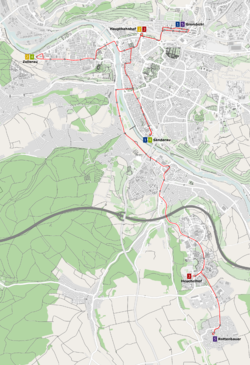The Würzburg tramway network (German: Straßenbahnnetz Würzburg) is a network of tramways forming part of the public transport system in Würzburg, a city in the federal state of Bavaria, Germany.
| Würzburg tramway network | ||||||||||||||||||||||||||||||||
|---|---|---|---|---|---|---|---|---|---|---|---|---|---|---|---|---|---|---|---|---|---|---|---|---|---|---|---|---|---|---|---|---|
 A GT-N tram crossing the Löwenbrücke, Würzburg, 2007 | ||||||||||||||||||||||||||||||||
| Operation | ||||||||||||||||||||||||||||||||
| Locale | Würzburg, Bavaria, Germany | |||||||||||||||||||||||||||||||
| ||||||||||||||||||||||||||||||||
| ||||||||||||||||||||||||||||||||
The network presently consists of five lines,[1] with a total track length of 42 kilometres (26 mi)[3] (yielding a one-way route length of approximately 21 kilometres (13 mi)). It is currently operated by Würzburger Straßenbahn GmbH, a subsidiary of Würzburger Versorgungs- und Verkehrs-GmbH (WVV), and integrated in the Verkehrsverbund Mainfranken (VVM).
History edit
The first horse-drawn tramway opened in Würzburg in 1892.[3][4] The first electric trams went into operation in Würzburg in 1900.[3]
Beginning in the 1990s, a concerted effort was made to move Würzburg's tramlines into their own rights-of-way and convert them more to a light rail (Stadtbahn) type of operation over the traditional tram system operating in regular road traffic. Currently, most of Würzburg tramlines, outside of sections downtown and in the Sanderau district, operate as light rail in their own rights-of-way. In addition, low-floor light rail vehicles were purchased.
Lines edit
As of 2013[update], the network was made up of the following five lines:[1][2]
| Line | Route | Travel time | Length* |
|---|---|---|---|
| 1 | Grombühl Uni-Kliniken – Hauptbahnhof – Juliuspromenade – Stadtmitte – Sanderring – Sanderau | 20 min | 10.4 km |
| 2 | Hauptbahnhof – Juliuspromenade – Wörthstraße – Zellerau | 14 min | 8.0 km |
| 3 | Hauptbahnhof – Juliuspromenade – Stadtmitte – Sanderring – Steinbachtal – Reuterstraße – Heuchelhof | 27 min | 19.3 km |
| 4 | Sanderau – Sanderring – Stadtmitte – Wörthstraße – Zellerau | 23 min | 12.6 km |
| 5 | Grombühl Uni-Kliniken – Hauptbahnhof – Juliuspromenade – Stadtmitte – Sanderring – Steinbachtal – Reuterstraße – Heuchelhof – Rottenbauer | 39 min | 26.2 km |
* The figure refers to both directions, ie a complete round trip.
Rolling stock edit
The Würzburg tram fleet consists of:[5]
- GTW-D8 (6 trams, built by Düwag in 1968)
- GT-E (14 trams, built by LHB in 1989)
- GT-N (20 trams, built by Alstom LHB in 1995)
An Artic tram was tested on the network in October 2014.[6] 18 new low-floor trams were ordered from HeiterBlick in 2019, with deliveries scheduled to begin in 2022.[5]
-
GTW-D8
-
GT-E
-
GT-N (left)
-
Transtech Artic
See also edit
References edit
Notes edit
- ^ a b c "Linieninformationen - Großwabe Würzburg" [Line Information - (in) the Würzburg 'honeycomb'] (in German). Verkehrsunternehmens-Verbund Mainfranken GmbH (VVM). Archived from the original on 2016-06-22. Retrieved 2013-10-04.
- ^ a b c "Liniennetz der Straßenbahn in Würzburger" [Tram Line Network in Würzburg] (PDF) (in German). Verkehrsunternehmens-Verbund Mainfranken GmbH (VVM). September 2010. Archived from the original (PDF) on 2016-05-20. Retrieved 2013-10-04.
- ^ a b c d e f "Nahverkehr - Fahrgäste - Wissenswertes - Straßenbahn der WSB - Übersicht" [Suburban Traffic - Passengers - Things worth knowing - The Tram of the WSB - Overview] (in German). Würzburger Versorgungs- und Verkehrs-GmbH (WVV). Retrieved 2013-10-04.
- ^ "Über uns - Historie - Übersicht" [About us - History - Overview] (in German). Würzburger Versorgungs- und Verkehrs-GmbH (WVV). Retrieved 2013-10-04.
- ^ a b "Würzburg bestellt Niederflurstraßenbahnen bei HeiterBlick" [Würzburg orders low-floor trams from HeiterBlick]. Urban Transport Magazine (in German). December 18, 2019. Archived from the original on December 18, 2019. Retrieved December 18, 2019.
- ^ Schindelmann, Jasmin (December 8, 2014). "Straba-Test: Begeistert vom finnischen Fahrkomfort" [Tram-test: Thrilled by the Finnish driving comfort]. mainpost.de (in German). Main-Post GmbH. Archived from the original on December 18, 2019. Retrieved December 18, 2019.
Bibliography edit
- Hendlemeier, Wolfgang (1981). Handbuch der deutschen Straßenbahngeschichte [Handbook of German Tram History] (in German). Vol. 1. München.
{{cite book}}: CS1 maint: location missing publisher (link) - Höltge, Dieter; Kochems, Michael (2006). Straßen- und Stadtbahnen in Deutschland [Tramways and Stadtbahnen in Germany]. Vol. Band 10: Bayern [Volume 10: Bavaria]. Freiburg i. B., Germany: EK-Verlag. ISBN 388255391X. (in German)
- Klebes, Günther (1980). Die Strassenbahnen Bayerns in alten Ansichten [The Trams of Bavaria in Old Postcards] (in German). Zaltbommel. ISBN 90-288-1197-4.
{{cite book}}: CS1 maint: location missing publisher (link) - Schwandl, Robert (2012). Schwandl's Tram Atlas Deutschland (in German and English) (3rd ed.). Berlin: Robert Schwandl Verlag. pp. 140–141. ISBN 9783936573336.
External links edit
- Würzburger Versorgungs- und Verkehrs-GmbH (WVV) – official site (in German)
- Verkehrsunternehmens-Verbund Mainfranken GmbH (VVM) – official site (in German)
- Würzburg database / photo gallery and Würzburg tram list at Urban Electric Transit – in various languages, including English.
- Würzburg database / photo gallery at Phototrans – in various languages, including English.
